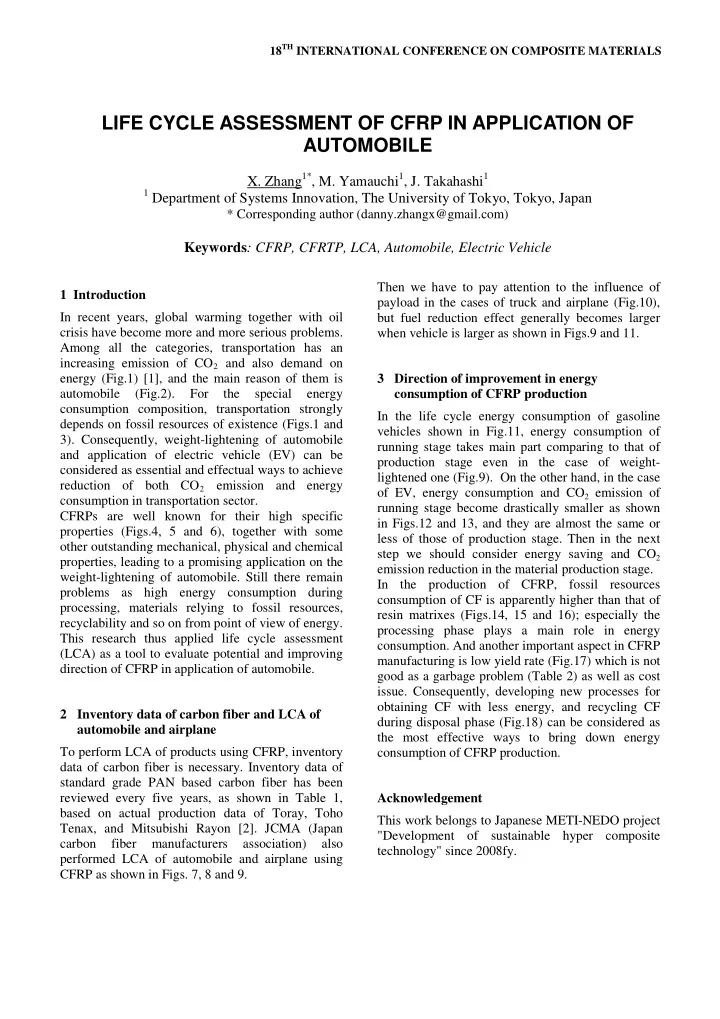

18 TH INTERNATIONAL CONFERENCE ON COMPOSITE MATERIALS LIFE CYCLE ASSESSMENT OF CFRP IN APPLICATION OF AUTOMOBILE X. Zhang 1* , M. Yamauchi 1 , J. Takahashi 1 1 Department of Systems Innovation, The University of Tokyo, Tokyo, Japan * Corresponding author (danny.zhangx@gmail.com) Keywords : CFRP, CFRTP, LCA, Automobile, Electric Vehicle Then we have to pay attention to the influence of 1 Introduction payload in the cases of truck and airplane (Fig.10), In recent years, global warming together with oil but fuel reduction effect generally becomes larger crisis have become more and more serious problems. when vehicle is larger as shown in Figs.9 and 11. Among all the categories, transportation has an increasing emission of CO 2 and also demand on energy (Fig.1) [1], and the main reason of them is 3 Direction of improvement in energy consumption of CFRP production automobile (Fig.2). For the special energy consumption composition, transportation strongly In the life cycle energy consumption of gasoline depends on fossil resources of existence (Figs.1 and vehicles shown in Fig.11, energy consumption of 3). Consequently, weight-lightening of automobile running stage takes main part comparing to that of and application of electric vehicle (EV) can be production stage even in the case of weight- considered as essential and effectual ways to achieve lightened one (Fig.9). On the other hand, in the case reduction of both CO 2 emission and energy of EV, energy consumption and CO 2 emission of consumption in transportation sector. running stage become drastically smaller as shown CFRPs are well known for their high specific in Figs.12 and 13, and they are almost the same or properties (Figs.4, 5 and 6), together with some less of those of production stage. Then in the next other outstanding mechanical, physical and chemical step we should consider energy saving and CO 2 properties, leading to a promising application on the emission reduction in the material production stage. weight-lightening of automobile. Still there remain In the production of CFRP, fossil resources problems as high energy consumption during consumption of CF is apparently higher than that of processing, materials relying to fossil resources, resin matrixes (Figs.14, 15 and 16); especially the recyclability and so on from point of view of energy. processing phase plays a main role in energy This research thus applied life cycle assessment consumption. And another important aspect in CFRP (LCA) as a tool to evaluate potential and improving manufacturing is low yield rate (Fig.17) which is not direction of CFRP in application of automobile. good as a garbage problem (Table 2) as well as cost issue. Consequently, developing new processes for obtaining CF with less energy, and recycling CF 2 Inventory data of carbon fiber and LCA of during disposal phase (Fig.18) can be considered as automobile and airplane the most effective ways to bring down energy To perform LCA of products using CFRP, inventory consumption of CFRP production. data of carbon fiber is necessary. Inventory data of standard grade PAN based carbon fiber has been reviewed every five years, as shown in Table 1, Acknowledgement based on actual production data of Toray, Toho This work belongs to Japanese METI-NEDO project Tenax, and Mitsubishi Rayon [2]. JCMA (Japan "Development of sustainable hyper composite carbon fiber manufacturers association) also technology" since 2008fy. performed LCA of automobile and airplane using CFRP as shown in Figs. 7, 8 and 9.
References [1] http://iea.org/ [2] http://www.carbonfiber.gr.jp/english/index.html [3] J. Kasai, The International Journal of Life Cycle Assessment , Vol.5, No.5, p.316, 2000. Fig.4 Tensile properties of structural materials. Fig.1 World energy consumption structure. Fig.2 Energy consumption structure of Japanese Fig.5 Flexural properties of structural materials. transport sector. Fig.6 Influence of carbon fiber volume fraction in Fig.3 Proportion of the transport sector accounted CF/PP panel on the weight lightening ratio for world oil consumption. to steel panel under flexural load.
LIFE CYCLE ASSESSMENT OF CFRP IN APPLICATION OF AUTOMOBILE Table 1 Inventory data of standard grade PAN based carbon fiber [2]. Energy CO 2 SO x NO x (MJ/kg- (kg/kg- (kg/kg- (kg/kg- CF) CF) CF) CF) First 478.5 29.7 0.068 2.009 data at 1999 Recalculated 285.9 20.5 0.02 0.146 data at 2004 Recalculated 286 22.4 0.019 0.121 data at 2009 Fig.10 Influence of payload on the reduction of fuel consumption. Fig.7 “JCMA Model” for LCA of Automobile [2]. Fig.11 Life cycle energy consumption of various types of vehicles [3]. Fig.8 “JCMA Model” for LCA of Airplane [2]. Fig.12 Energy consumption structure of plug-in hybrid electric vehicles. Fig.9 CO 2 reduction effects by applying CFRP [2]. 3
Fig.13 CO 2 emission structure of plug-in hybrid Fig.17 Schematic diagram of the occurrence of electric vehicles. industrial CFRP waste. Table 2 World carbon fiber potential demand by application. Fig.14 Fossil resources consumption in material production. Fig.15 Fossil resources consumption in resin matrix production. 80 Energy consumption [MJ] 70 60 process of resin 50 material of resin 40 process of CF material of CF 30 molding 20 10 0 0 0.1 0.2 0.3 0.4 0.5 0.6 Vf Fig.18 Energy intensity in parts production by fresh Fig.16 Energy consumption structure of CF/PP. and recycled materials.
Recommend
More recommend